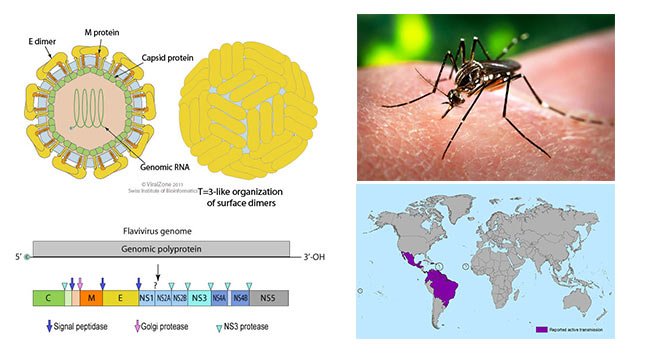Zika Virus (ZIKV) is mosquito-borne emerging flavivirus which was first identified in Zika Forest of Uganda in 1947 in rhesus monkeys. It was later identified in humans in 1968 for the first time in Nigeria. Different outbreaks of Zika virus disease have been recorded in Africa, the Americas, Asia and the Pacific. Its infection is caused by the bite of an infected Aedes mosquito, usually causing mild fever, rash, conjunctivitis, and muscle pain. In Brazil in May 2015, the Pan American Health Organization (PAHO) issued an alert regarding the first confirmed Zika virus infections.
Group: Group IV ((+) ssRNA)
Family: Flaviviridae
Genus: Flavivirus
Species: Zika virus
Structure of Zika Virus
- The virion is approximately 40 nm in diameter with surface projections that measure roughly 5-10 nm.
- Nucleocapsid is 25-30 nm in diameter surrounded by a host-membrane derived lipid bilayer.
- Enveloped
- Icosahedral
- Contains envelope proteins E and M

Genome of Zika Virus
- Non-segmented, single-stranded, positive-sense RNA genome
- 10794 bases long with two non-coding regions flanking regions known as the 5′ NCR and the 3′ NCR.

Sign and Symptoms of Zika Virus
These symptoms are mild and usually last for 2-7 days.
- Headache
- Fever
- Skin rashes (exanthema)
- Pink eye
- Conjunctivitis
- Muscle and joint pain
- Malaise
Symptoms are similar to that of dengue or chikungunya.
Epidemiology of Zika Virus
- The virus was first isolated in 1947 from a rhesus macaque in the Zika Forest of Uganda.
- It was later identified in humans in 1968 for the first time in Nigeria
- The first major outbreak, with 185 confirmed cases, was reported in 2007 in the Yap Islands.
- The first cases confirmed in Brazil was in May 2015 and the country is currently experiencing the largest epidemic ever recorded with 440,000 to 1,300,000 suspected cases reported by the Brazilian health authorities.
- There are 3174 cases and 38 deaths from microcephaly in Brazil as of 21 October 2015.
- There has been total death of 152 as of 21 October 2015 in the world.
Affected Countries: Barbados, Bolivia, Brazil, Colombia, the Dominican Republic, Ecuador, El Salvador, French Guiana, Guatemala, Guadeloupe, Guyana, Haiti, Honduras, Martinique, Mexico, Panama, Paraguay, Puerto Rico, Saint Martin, Suriname, and Venezuela.
Countries and territories with active Zika virus transmission as of Jan 2016.

Since November, Brazil has seen nearly 4,000 cases of microcephaly in babies born to women who were infected with Zika during their pregnancies.
Transmission of Zika Virus
- Zika virus is transmitted from one people to another through the bite of an infected Aedes mosquito, mainly Aedes aegypti in tropical regions.
- There has been one report of possible spread of the virus through blood transfusion and one report of possible spread of the virus through sexual contact.
- In 2015, Zika virus RNA was detected in the amniotic fluid of two fetuses, indicating that it had crossed the placenta and could cause a mother-to-child infection.
- The Asian tiger mosquito, Aedes albopictus, is also known to transmit the virus, but it is not clear how efficiently.
- To date, there are no reports of infants getting Zika virus through breastfeeding.
Pathogenesis of Zika Virus
- Incubation period in mosquitoes is about 10 days.
- The vertebrate hosts of the virus are primarily monkeys and humans.
- The pathogenesis of the virus is hypothesized to start with an infection of dendritic cells near the site of inoculation, followed by a spread to lymph nodes and the bloodstream. Flaviviruses generally replicate in the cytoplasm, but Zika virus antigens have been found in infected cell nuclei.
- Infection with the virus appears to be linked to the development of unusually small heads and brain damage in newborns (microcephaly).
- The most dangerous time is thought to be during the first trimester of Pregnancy– when some women do not realize they are pregnant. Experts do not know how the virus enters the placenta and damages the growing brain of the fetus.
Diagnosis of Zika Virus
Sample: Blood, Saliva, Urine.
PCR: It is useful in the first 3-5 days after the onset of symptoms. It helps in the direct detection of Zika virus RNA or specific viral antigens in clinical specimens.
Serology Test: It detect the presence of antibodies but are useful only after five days.
Treatment of Zika Virus
There is no specific treatment or vaccine currently available.
Prevention and Control of Zika Virus
- Avoid travel to areas with an active infestation.
- Travelers should take the basic precautions to protect themselves from mosquito bites.
- During outbreaks, health authorities may advise that spraying of insecticides be carried out.
- Reducing mosquito populations and avoiding bites, which occur mainly during the day.
- Eliminating and controlling Aedes aegypti mosquito breeding sites reduces the chances that Zika will be transmitted.
References
- Centers for Disease Control and Prevention (CDC)- Zika Virus.
- WHO, Media Centre, Fact sheets- Zika virus.
- Pan American Health Organization- Zika Virus Infection.
- CNN- Five things you need to know about Zika.
- CBC Radio Canada- Zika virus: what you need to know.
- Guardian News and Media Limited- Zika virus: what travellers need to know.
- The New York Times Company- Short Answers to Hard Questions About Zika Virus.
- Vox Media, Inc.- Zika virus, explained in 6 charts and maps.
- Microbeonline- Zika virus: Transmission, Pathogenesis, symptoms and laboratory diagnosis.
- Wikipedia- Zika virus.
Similar Posts:
- Hepatitis B Virus- Structure, Epidemiology, Symptoms, Pathogenesis, Diagnosis, Treatment and Vaccines
- Cryptococcus Neoformans – Habitat, Morphology, Epidemiology, Virulence Factors, Treatment + More
- Histoplasma Capsulatum – Habitat, Morphology, Epidemiology, Virulence Factors, Treatment + More
- Techniques of Virus Cultivation


only precautionary measures like, keeping ourselves away from mosquito bites, by keeping the surroundings clean.